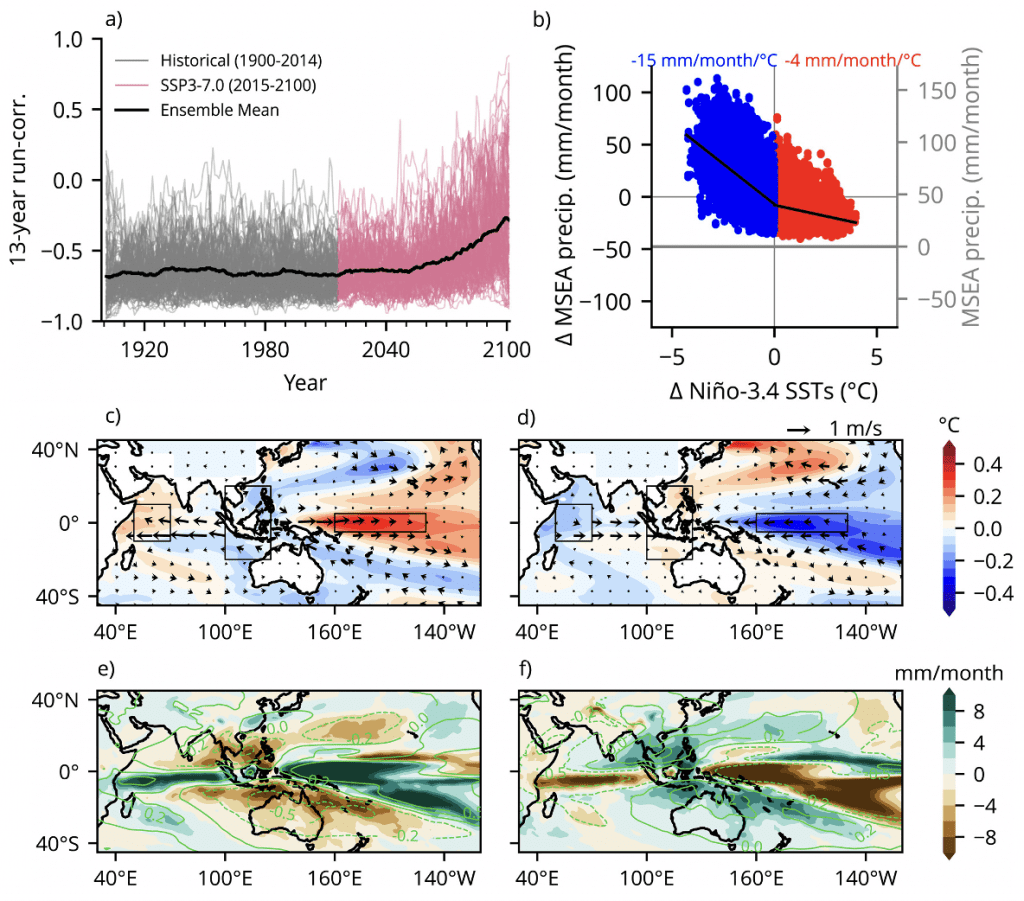Le Roy, E. J., & Ummenhofer, C. C. (2025). Past and Future Modulation of the ENSO Teleconnection to Southeast Asian Rainfall by Interbasin Interactions. Geophysical Research Letters, 52, e2024GL111916. https://doi.org/10.1029/2024GL111916

a) Modeled 13-year running correlation coefficient of Mainland Southeast Asia (MSEA) precipitation for March-May (year 0) with the Niño3.4 index for December-February (year -1) in LENS2 for the individual ensemble members (light gray and pink lines) and ensemble mean (thick black line). b) Relationship between the December-February (year -1) Niño3.4 index and March-May (year 0) precipitation (right y-axis) and precipitation anomalies (left y-axis) averaged over the MSEA region in LENS2 (1900–2014). c) December-February (year -1) SST anomalies (shading; °C) and 850-hPa wind anomalies (vectors; 1 m/s) during positive phases of the Tropical Tripole Pattern, when ENSO and MSEA precipitation are uncorrelated, for 13-year periods in LENS2 (1900-2014). d) Same as (c ) but during negative phases of the Tropical Tripole Pattern, when ENSO and MSEA precipitation are strongly correlated. e) March-May (year 0) precipitation anomalies (shading; mm/month) and total, vertically-integrated, precipitable water (contour lines; kg/m2) during positive phases of the Tropical Tripole Pattern for 13-year periods in LENS2 (1900-2014). f) Same as (e ) but during negative phases of the Tropical Pattern. Image provided by E.J. Le Roy.
ENSO’s teleconnection with rainfall in mainland Southeast Asia (MSEA) indicates a large degree of variability on decadal timescales. This study uses the Community Earth System Model version 2 Large Ensemble (LENS2) to identify conditions that amplify or dampen the ENSO teleconnection to rainfall in the MSEA region. Composite analyses reveal that decades with a strong ENSO-rainfall relationship are characterized by a tripolar pattern in sea surface temperatures spanning the Indian Ocean, central Indo-Pacific Warm Pool, and western Pacific regions, and an overall wetter mean state. Because the ENSO teleconnection is asymmetric, negative phases of the tripolar pattern enhance wet conditions during La Niña events whereas dry conditions during El Niño events are not similarly exacerbated during positive phases. By 2100, future projections indicate the emergence of a positive tripole pattern and a weakening of ENSO’s influence on rainfall in the MSEA region. As a result, ENSO indices, such as the Niño-3.4 index, will become less reliable for predicting springtime rainfall in this area.
